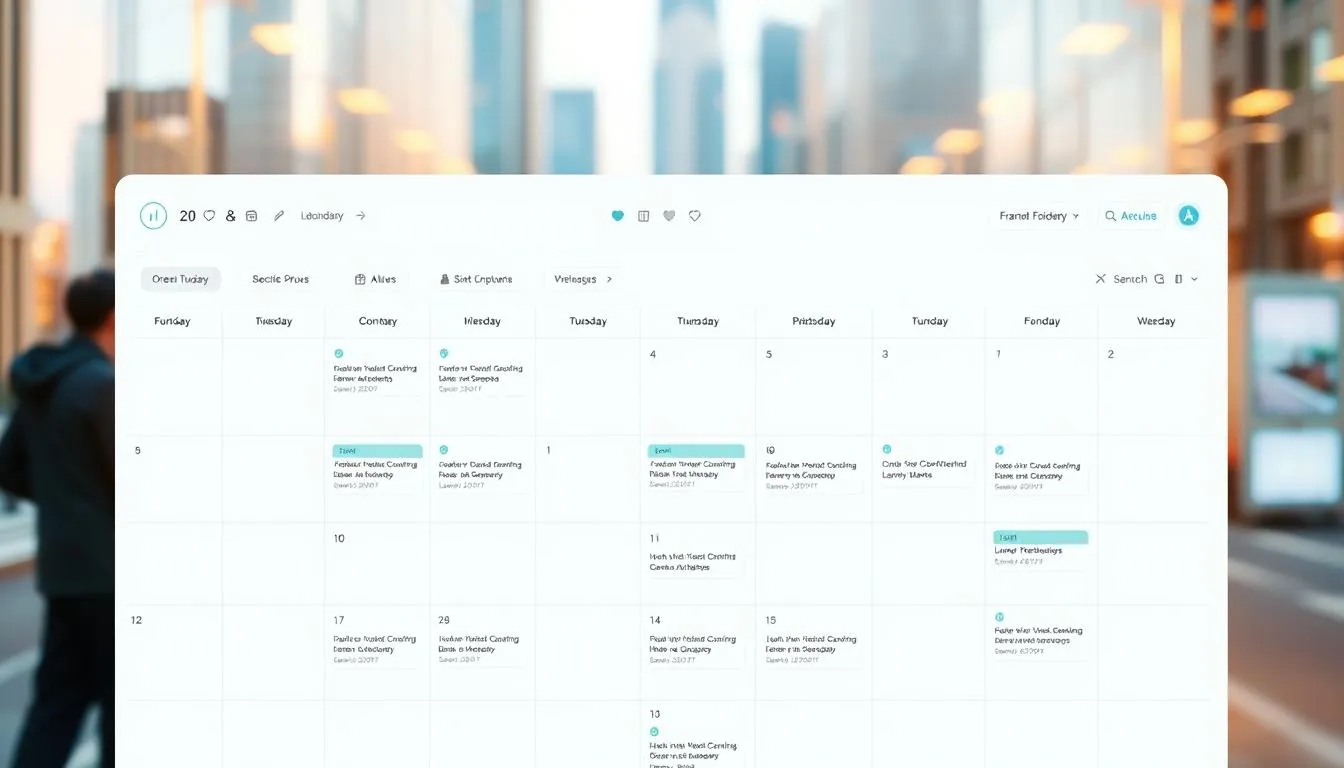56% of marketers say their teams now use AI to boost efficiency, precision, and creative wins.
That shift changes how a simple calendar works. An intelligent content calendar becomes a living system that maps posts across channels, pins peak posting windows, and turns ideas into a repeatable plan. For quick content formats that work well with calendar planning, explore our micro-blogging tutorials.
These systems analyze trends, audience behavior, and competitors to suggest optimal posting times and content types. To maximize your content’s reach across platforms, explore our guide on content repurposing roadmaps. They automate scheduling, repurposing, and cross-platform coordination so teams spend less time tracking tasks and more time creating.
From free tools like CoSchedule and Voilà to robust workspaces like ClickUp and Team-GPT, options range from quick social schedulers to full workflows with approvals, briefs, and collaboration. For strategies to develop comprehensive content, check out our guide on maximizing impact with long-form evergreen guides. This guide helps you compare features, pricing, and use cases so you can pick the right tool and move from research to execution fast.
Learn how to build a practical plan and measure performance with clear loops for continuous improvement at create a content calendar with AI.
Key Takeaways
- AI turns a static calendar into a dynamic planning and execution system.
- Automated schedules reduce manual posting and context switching.
- Tools range from free generators to full collaboration platforms.
- Focus on audience, timing, and repeatable workflows when choosing a tool.
- Measure results and iterate to keep your plan improving.
Why AI-assisted content calendars matter right now
Today’s smart planners turn noisy market signals into a prioritized queue of posts and formats. They read trends, audience behavior, and platform rhythm to automate scheduling and personalize messaging.
That shift matters for marketing teams. A responsive calendar improves visibility across projects so teams don’t miss deadlines or duplicate work across platforms. Predictive posting windows and automated queues save time and keep publishing consistent during busy campaigns.
Smaller teams gain a big-league edge. Intelligent recommendations score topics, suggest formats, and surface high-impact opportunities so fewer decisions stall. Centralized planning ties design, copy, social, and leadership into one source of truth.
- Prioritizes what to publish and when based on live audience signals.
- Reduces manual management with automated queues and predictive time slots.
- Boosts engagement and business outcomes by aligning posts with measurable goals.
Key benefits for marketers and teams
Smart planning frees time and sharpens results. An intelligent calendar automates routine scheduling and pre-fills slots with relevant ideas drawn from trending topics. Tools like CoSchedule use Best Time Scheduling while StoryChief’s “William” surfaces competitor-aware suggestions to guide your plan.
Save time with automated planning and scheduling
Automate repetitive work so your team spends less time on posting and more on strategy. Automated scheduling can pre-fill weeks of posts, cutting coordination overhead and meeting deadlines without extra meetings.
Improve content performance with data-driven insights
Use predictive analytics to pick formats, channels, and timing that lift performance. Continuous monitoring creates optimization loops that increase reach, engagement, and conversions over time.
Scale personalization across channels and audiences
Segment audiences and map messages to pain points across social media, blogs, and email. Consistent publishing stays easy when queues and approvals live inside one calendar view.
- Quantify time saved by automating scheduling and idea generation.
- Choose formats and windows based on data, not guesswork.
- Keep cadence consistent across media while scaling personalization.
What to look for in AI-assisted content calendars
Choose a platform that maps strategy to individual posts, so every item has a purpose. The right calendar turns vague plans into repeatable workstreams and reduces friction across teams.
Post-type templates and goal-based prompts
Start with templates that ask about audience, CTA, and format. Templates keep each entry aligned to a goal from the first draft.
Multi-channel views with auto-publishing and drag-and-drop
Pick tools with a unified view for LinkedIn, Instagram, blogs, and newsletters. Drag-and-drop changes and direct publishing cut handoffs and speed up planning.
Built-in repurposing and content recycling
Repurpose intelligently: convert one article into platform-ready posts and recycle top performers with small edits. Auto-tagging by theme helps group topics and reuse what works.
Collaboration features: roles, approvals, comments
Ensure the system supports roles, version history, approvals, and inline comments. Good collaboration tools reduce meetings and keep management lean.
AI quality, tone adaptation, and in-tool editing
Evaluate AI that adapts tone and offers partial regenerations inside the editor. Granular edits let writers tweak hooks or CTAs without rebuilding an entire piece.
- Prioritize templates that require audience and CTA details.
- Choose a multi-channel calendar with auto-publish and drag-and-drop.
- Insist on repurposing, auto-tagging, and flexible workflows.
Best AI content calendar tools to try in 2025
Top platforms now shorten the gap between ideas and publishing. Below are practical picks that match different workflows, from solo creators to teams.

Team-GPT
Strength: Reusable prompt systems for consistent multi-channel planning.
Tradeoff: No built-in scheduling; starts at $25/user/month.
ClickUp
Strength: End-to-end workspace with calendar, tasks, statuses, and AI assistant.
Tradeoff: More features to configure; free tier and paid from $7/user/month.
“Match the tool to how you publish—automation matters less than fit.”
| Tool | Strength | Tradeoff | Starting Price |
|---|---|---|---|
| Voila AI | Fast free calendar generator | No team scheduling | Free |
| Galaxy.AI | Calendar + visuals; advanced timing tips | Advanced mode learning curve | Free |
| GravityWrite | Platform-specific social calendars, tone options | Limited collaboration depth | From $19/mo |
| LogicBalls | Frictionless creators, 1,200+ tool links | Limited history in free | Free |
| Easy-Peasy.ai / Wittypen / ChatGPT / Claude / CoSchedule | Range from GPT‑4 builders to doc-enabled planning and Best Time Scheduling | Varying team features and costs | Free → $25+/mo |
Quick tip: Match each tool’s strength to your workflow maturity, collaboration needs, and publishing stack for better management and performance.
Use cases: From social media to blogs and email
Turn one idea into a coordinated campaign across feeds and inboxes. A solid plan lets you convert a single blog into LinkedIn carousels, Instagram reels, and newsletter features while keeping messaging consistent.
Multi-channel campaign planning
Coordinate formats: map LinkedIn carousels, reels, and newsletter slots in the same view so publishing aligns across platforms. Use tools like Galaxy.AI for mixed formats and CoSchedule for best-time optimization.
Blog-to-social repurposing and pillars
Create pillars (tutorials, case studies, product updates) and tag each entry so ideas recycle easily. Extract key takeaways, craft hooks, and schedule a sequence of posts to extend each blog post’s reach.
- Sequence a campaign week: early-week education, midweek proof, end-of-week conversion.
- Use templates for content types to speed production and preserve brand voice.
- Let AI suggest short posts, carousels, and emails to avoid repetitive feeds.
- Compare engagement by platform to refine the plan for the next sprint.
| Use case | Tool fit | Operational payoff |
|---|---|---|
| Multi-format campaigns | Galaxy.AI / GravityWrite | Consistent messaging across platforms |
| Scheduling with best times | CoSchedule | Higher open and engagement rates |
| Repurposing blog posts | Workflow + tagging | Longer asset life and fewer gaps in publishing |
Operational payoff: fewer gaps in publishing, more reliable funnel coverage, and a repeatable plan that turns ideas into sustained results. Learn more about practical workflows at how to use AI for content.
How to choose the right tool for your team
The best calendar fits your people and process. Start by listing who approves posts, which apps must integrate, and what security your business requires.
Solo creators often pick fast, free generators like Voila, Wittypen, or LogicBalls. These tools let a single person sketch a weekly plan and test ideas without heavy management or approvals.
Growing teams benefit from ClickUp or CoSchedule. Choose platforms with shared calendars, statuses, templates, and publishing tied to task management so collaboration stays clear and repeatable.
Enterprises need SSO, usage controls, and reusable prompt libraries to standardize output across brands or regions. Team-GPT’s Starter ($25/user/month) and Growth ($35/user/month) plans suit that scale. ClickUp also offers paid tiers from $7/user/month with advanced security.
- Selection framework: collaboration depth, security, integrations, publishing needs.
- Weigh AI draft quality and editing controls for on-brand review cycles.
- Map must-have features to current workflows to avoid overbuying complexity.
- Use free tiers to pilot before a full team rollout.

“Match the tool to how you publish—automation matters less than fit.”
Integrations and workflow fit
Making the calendar part of your tech stack prevents work from stalling. Integrations connect planning to execution so approved posts flow from brief to publish without extra manual steps.
Connect scheduling and publishing: link your calendar to schedulers like Buffer or Hootsuite so approved posts publish at optimal times automatically. CoSchedule also offers built-in social scheduling and paid AI image generation, which can remove a step for teams that need everything in one place.
Link to DAMs and asset libraries to cut down time hunting for images and templates. ClickUp integrates with 1,000+ apps (Slack, Trello, Notion, Airtable), making asset retrieval and versioning simple and traceable.
Approval flows and version control
Define where briefs live, who approves, and how comments move a task to done. Keep approvals and sign-offs inside the same plan view to reduce handoffs.
Use version history and audit trails so every change is logged. That preserves quality and accountability during busy campaigns and helps when you must review edits or revert a file.
Practical collaboration touchpoints
- Map handoffs from strategy → copy → design → publishing right in the calendar.
- Integrate chat and docs (Slack, Notion) for fast feedback without leaving the plan.
- Prioritize simple integrations that remove steps, not add new work silos.
Tip: If your planning tool lacks native publishing, pair it with a scheduler. That preserves workflow benefits while keeping your process lean. For more on calendar generators and integrations, see AI content calendar generators.
Measuring content performance and ROI
Measure what you schedule: link every calendar entry to a clear KPI so results tell you what to repeat.
 Analytics and predictive insights let tools flag the best days and times to post. StoryChief’s assistant watches competitors and audience shifts. CoSchedule surfaces optimal posting windows and performance signals that refine your topics and formats.
Analytics and predictive insights let tools flag the best days and times to post. StoryChief’s assistant watches competitors and audience shifts. CoSchedule surfaces optimal posting windows and performance signals that refine your topics and formats.
Analytics, predictive insights, and optimization loops
Define a measurement plan that ties each item in your plan to reach, engagement, traffic, or conversions. Use the calendar’s reporting to spot winners and underperformers.
- Predictive analytics: recommends post timing and tweaks to lift results.
- Optimization loops: review, adjust, and republish to compound gains across sprints.
- A/B testing: test hooks, thumbnails, and CTAs and track impact at the calendar level.
Staying on-brand while improving engagement
Keep tone controls and approval workflows active so testing doesn’t dilute your voice. Turn findings into templates and playbooks to scale winning approaches.
Report directly from the calendar to align stakeholders on what to repeat or retire and to inform the next wave of topics and audience-focused strategy.
Measure content performance from scheduling to ROI so your marketing plan earns measurable results.
Pricing snapshots and value considerations
Pricing is about more than monthly fees; it governs adoption and returns. Choose a plan that matches your team’s needs today and scales as your plan and publishing grow.
Free vs. paid plans and where limitations matter
Free generators like Voila, Galaxy.AI, Wittypen, and LogicBalls let small teams and solo creators start fast. They speed idea-to-schedule work but lack collaboration, integrations, and history.
Paid suites — ClickUp (free + paid from $7/month), CoSchedule (free to start with paid AI image generation), and Team-GPT (from $25/user/month) — add robust integrations, analytics, and security for growing teams.
Total cost of ownership and adoption curve
Evaluate TCO beyond license fees. Account for setup, training, process changes, and integration maintenance. Early support, templates, and reusable prompts cut the learning curve and speed value realization.
- Pilot a small project to validate fit before full rollout.
- Calculate weekly time savings from scheduling, approvals, and production.
- Factor in reusable prompts and templates that compound ROI over months.
| Plan | Best for | Core limits | Starting price |
|---|---|---|---|
| Voila / Wittypen / LogicBalls | Solo creators, quick starts | No team workflows, limited history | Free |
| Galaxy.AI | Mixed-format testing | Integrations limited, learning curve | Free |
| ClickUp | Growing teams | Some setup required | Free → from $7/mo |
| CoSchedule / Team-GPT | Enterprise publishing | Costly but full features & security | Free→Paid / from $25/user |
Getting started today: A simple step-by-step
Ready to move from strategy to action? Follow a short, practical sequence that turns big goals into weekly work you can measure.
Define goals, audience, and posting cadence
Step 1: Set clear goals and KPIs—brand awareness, leads, or conversions—so each entry ladders up to outcomes.
Step 2: Analyze your target audience and competitors to pick topics, formats, and channels that will resonate.
Step 3: Curate ideas and map them into weekly slots. Include blog posts, social sequences, and newsletter highlights in your content plan.
Step 4: Optimize drafts for SEO and social. Tweak titles, hashtags, and metadata using tool recommendations to improve discoverability.
Step 5: Set posting cadence by channel and use best-time scheduling features to automate publishes and save time.
Step 6: Create content right inside the plan using templates and prompts, then route items through approvals to keep quality on brand.
Step 7: Publish, monitor results, and update the plan. Close the loop by logging learnings so the next sprint improves.
- Quick start: Pick a free tool to test one workflow this week.
- Graduate to a paid plan when collaboration, asset management, or native publishing becomes essential.
Conclusion
Close your planning loop with a simple system that turns ideas into measurable weekly work. An AI-powered content calendar brings structure and speed to planning, production, and publishing in one coordinated view.
Start small: pilot a focused campaign with free tools like Voila or Galaxy.AI to test workflows and audience response. Then move to platforms such as ClickUp, CoSchedule, or Team-GPT when you need collaboration, publishing, and reusable systems for scale.
Practical path: pick the right tool for your team stage, measure impact, and scale winners. The result is clearer priorities, saved time, stronger performance, and a repeatable engine for your content strategy and business marketing plan.
FAQ
What is an AI-assisted content calendar and how does it help my marketing?
An AI-assisted content calendar uses machine learning to plan, suggest, and schedule posts across channels. It speeds up planning, suggests topics and post types, and helps teams maintain consistency while improving engagement and reach.
Which features should I prioritize when choosing a calendar tool?
Look for post-type templates, multi-channel scheduling, drag-and-drop planning, repurposing workflows, role-based approvals, and in-tool editing with tone adaptation. These features keep campaigns organized and scalable.
Can these tools actually improve content performance?
Yes. Tools with analytics and predictive insights highlight what resonates, recommend optimal posting times, and surface topics that drive clicks and conversions, helping you refine strategy over time.
Are there tools suited for solo creators versus teams or enterprises?
Absolutely. Solo creators often prefer lightweight, low-cost builders like Voila AI or Wittypen. Growing teams benefit from ClickUp or CoSchedule for task and approval management. Enterprises need platforms with advanced integrations and governance like Galaxy.AI or LogicBalls.
How important are integrations with scheduling, DAMs, and collaboration platforms?
Very important. Seamless integrations speed up publishing, centralize assets, and preserve version control. Connectors to social schedulers, digital asset managers, and Slack or Microsoft Teams reduce friction and speed approvals.
What’s the best way to repurpose blog posts for social and email?
Start with core pillars, extract headlines and quotes, create short-form posts for social, and craft condensed snippets for newsletters. Use repurposing features to track variants and schedule staggered distribution for maximum reach.
How do I measure ROI from using an AI-driven planner?
Track engagement, traffic, conversion rates, and time saved on planning. Use built-in analytics or connect to Google Analytics and CRM data to attribute leads and revenue back to scheduled campaigns.
What pricing models should I expect and what matters most?
Expect free tiers for basic calendars and paid plans for advanced AI, integrations, and team features. Evaluate total cost of ownership, onboarding time, and how quickly the tool delivers measurable improvements.
How quickly can my team adopt a new calendar tool?
Adoption depends on complexity and integrations. Simple builders can be live in a day. Platforms with task workflows and governance may take a few weeks for training and full rollout. Prioritize pilot runs and role-based onboarding.
Are there privacy or compliance concerns I should check?
Yes. Verify data handling, user access controls, and whether the vendor supports SOC 2, GDPR, or other relevant standards. For regulated industries, ensure approval flows and audit logs are available.
Can the in-tool AI adapt tone and brand voice reliably?
Many tools offer tone adaptation and brand guidelines that help keep messaging consistent. Test outputs, provide brand examples, and use editing features to refine copy before publishing for best results.
Do these calendars support multi-channel campaigns like LinkedIn, Instagram, and newsletters?
Yes. Top platforms support multi-channel planning, show calendar views per channel, and automate posting. They help coordinate campaign timing and repurpose assets across LinkedIn, Instagram, email, and blogs.
What is a practical first step to get started right away?
Define your goals, identify target audience segments, and set a posting cadence. Choose a tool that fits your team size, connect key platforms, and run a two-week pilot to refine workflows and measure impact.
